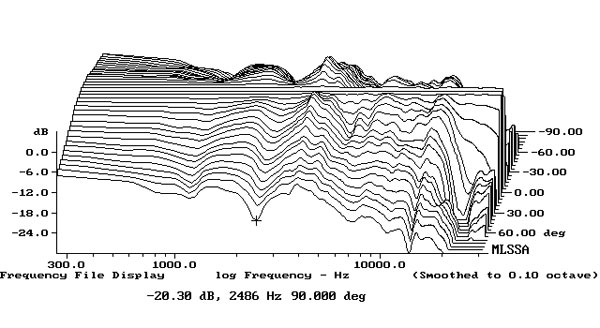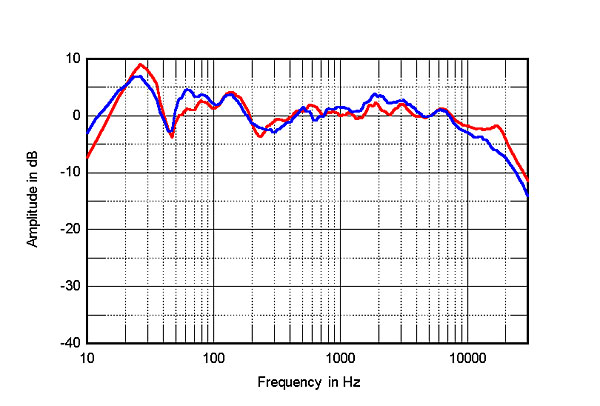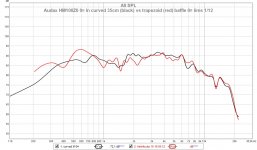Some more Edge excercises!
A 100mm (4") midrange on narrow/wide baffle, off-axis left/right/up
We notice that an offset mid might be very smooth on-axis but left/right offaxis response show different and quite strong deviations from linearity. Will this do harm to imaging?
A 100mm (4") midrange on narrow/wide baffle, off-axis left/right/up
We notice that an offset mid might be very smooth on-axis but left/right offaxis response show different and quite strong deviations from linearity. Will this do harm to imaging?
Attachments
Measurements of a curved 35cm wide baffle, midrange up crame 5cm from top of baffle
The mid exhibits a baffle width-related dip around 1,5kHz. So, definitely the way to go is to put mid on top of the tweeter in a narrow or trapezoid baffle. The baffle might have wide bevels to make it narrow, in Avalon or Diapason style!

The mid exhibits a baffle width-related dip around 1,5kHz. So, definitely the way to go is to put mid on top of the tweeter in a narrow or trapezoid baffle. The baffle might have wide bevels to make it narrow, in Avalon or Diapason style!

Attachments
Cabinet Design = When in doubt, copy off of the smart kids.
Best line I have read in a long time
What modelling software are you using?
What modelling software are you using?
I used Baffle Diffraction Simulator by Paul Verdone for my simulations. It displays one composite SPL graph with the diffraction effects for each driver, which helps me understand the interactions. It outputs the diffraction effects for each driver to separate FRD files.
The latest verion of Jeff Bagby's Xsim3D allows you to add a cabinet FRD file for each driver.
I used Baffle Diffraction Simulator by Paul Verdone for my simulations. It displays one composite SPL graph with the diffraction effects for each driver, which helps me understand the interactions. It outputs the diffraction effects for each driver to separate FRD files.
The latest verion of Jeff Bagby's Xsim3D allows you to add a cabinet FRD file for each driver.
I don't think Jeff Bagby wrote Xsim...
^I guess that the shape of enclosure is their tradition, that they persist on. Many have decided otherwise eg. B&W, Avalon, Sonus Faber, Vivid Audio, Magico, etc.
Their lates isn't terribly bad, bumps and dips are often compesated off-axis, look at room response!
Directivity, normalized

Room response , avaraged (red)

Their lates isn't terribly bad, bumps and dips are often compesated off-axis, look at room response!
Directivity, normalized

Room response , avaraged (red)

sure, keeping the dimensions as small as possible makes the square baffle to perform less bad.
wilson speakers also has a very inefficient use of internal box volumes, they often have very large outer structures but small enclosures, that in combo with small baffles can not be a optimum combination? how can there be no acoustic drawbacks?
wilson speakers also has a very inefficient use of internal box volumes, they often have very large outer structures but small enclosures, that in combo with small baffles can not be a optimum combination? how can there be no acoustic drawbacks?
- Status
- This old topic is closed. If you want to reopen this topic, contact a moderator using the "Report Post" button.
- Home
- Loudspeakers
- Multi-Way
- What determines baffle size and shape?


